Samsung Galaxy S 5 Review
by Anand Lal Shimpi & Joshua Ho on April 8, 2014 12:00 AM EST- Posted in
- Smartphones
- Samsung
- Mobile
- Galaxy S 5
Platform Power
The Galaxy S 5 includes Samsung's hallmark removable back cover and battery. The GS5 uses a 10.78Wh (2800mAh @ 3.85V) battery. The modest increase in battery capacity over the Galaxy S 4 is only a small part of the story. With the GS5, Samsung significantly improved the overall platform power story compared to the Galaxy S 4 (even more so than HTC's M7/M8 transition).
The move to a Snapdragon 801 SoC brings with it all of the performance and power efficiency benefits of the design and its updated 28nm HPm manufacturing process. The connectivity side sees a big improvement in power efficiency thanks to the use of Qualcomm's QFE1100 envelope tracker. Samsung also significantly reduced display power consumption on the GS5 compared to the GS4, which is likely the result of higher quantum efficiency (more brightness for less power), and panel self refresh. The result is a device that's bigger, faster and at the same time, far more power efficient than its predecessor. To me the biggest benefit of having a removable back cover and removable battery is the ability to quickly instrument the device to measure power consumption. I did just that with the Galaxy S 5 (T-Mobile) and GS4 (AT&T) to help characterize the improvement in total device power. All of the numbers below are taken with both displays calibrated to 200 nits.
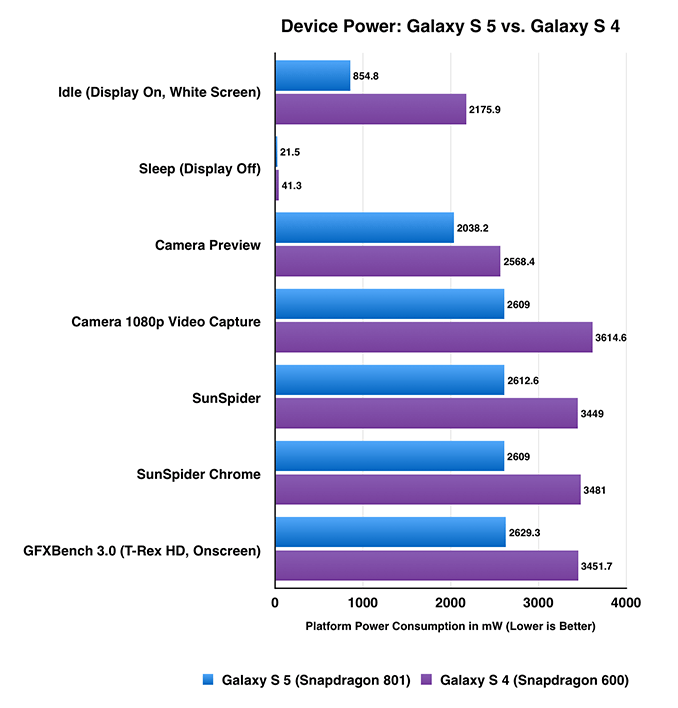
The GS4's display in particular was horribly inefficient, particularly at higher brightness values. The GS5 addresses that problem and appears to shoot for a sub-3W operating envelope in most situations. It is absolutely possible to get the device to draw more power than that however. Running a Speedtest while connected to T-Mobile's LTE network (with the display at minimum brightness), I measured an average power draw of 4.38W. With the display running at full brightness I measured 5.18W platform power draw while capturing 1080p video, and a whopping 6.54W while capturing 4K video. Assuming no thermal throttling, you could run through the GS5's battery in 1.64 hours by simply recording 4K video with the display set to max brightness.
I characterized the GS5's display power as well for those of you who are interested. Note that all of this data was gathered with both cellular and WiFi connected, but all background sync tasks disabled. I'm not reporting absolute minimums here but rather an average over a short idle period.
| Galaxy S 5 Device Power vs. Display Brightness | ||||||
| Minimum Brightness | 200 nits | Max Brightness | Max Brightness (w/ Boost) | |||
| Idle at Home Screen | 456.2mW | 591.2mW | 754.4mW | 1274.9mW | ||
| Idle Displaying White | 453.2mW | 1517.4mW | 2148.0mW | |||
You can see the impact content has on the AMOLED power draw by comparing the home/white rows. The GS5 display has a boost mode that kicks in when the ambient light sensor detects over 30,000 lux. The power penalty from running in this mode is pretty substantial as you'd expect. At worst, the GS5 will pull over 2W at idle while running in this max brightness boost mode. As is always the case, your display brightness has a big impact on battery life. If you run at max brightness you can conceivably run through your battery in 7 hours without doing anything at all. Run the display at 200 nits however (~60% on the GS5) and you can easily triple that battery life.
Ultra Power Saving Mode
The Galaxy S 5 has two low power modes that can be manually triggered: power saving and ultra power saving. The former offers the usual control over the CPU governor, limiting max frequency to 1.5GHz but keeping all four cores plugged in. You can also force the display into grayscale mode and choose to block background data.
Ultra power saving mode is the big new feature of the Galaxy S 5. In this mode all running apps are forced to quit, the display switches to grayscale mode, max brightness is clamped to 87 nits and the display refresh rate is reduced from 60Hz to 30Hz. When the screen turns off, ultra power saving mode turns off mobile data.WiFi and BT are also disabled upon entry (although you can manually re-enable them). Also in UPSM, Samsung disables two of the Krait 400 cores and caps the remaining two at 1.5GHz.
You can only run a handful of apps in ultra power saving mode, including Samsung's own browser (Phone, Messages, Internet, Calculator, ChatON, Clock, Google+, Memo and Voice Recorder).
Samsung claims that with only 10% left on your battery, switching into ultra power saving mode can give you up to 24 hours of standby time. To vet the claim I measured device power consumption while in UPSM. Just as before, this is total device power consumption measured at the battery.
| Galaxy S 5 Ultra Power Saving Mode | ||||||
| Sleep | Idle (Home Screen) | SunSpider | ||||
| Ultra Power Saving Mode | 16.8 mW | 421 mW | 1231.2 mW | |||
| Normal Mode (min brightness) | 21.5 mW | 2461.5 mW | ||||
Assuming a full battery can deliver 10.78Wh and a battery drained to 10% of that capacity only has 1.078Wh, if the GS5 consumes 16.8mW asleep with the display off on average I'd expect just over 64 hours of standby battery life - well above Samsung's claim of 24 hours. In reality, if you look at the power draw curve while sleeping the GS5 will wake up periodically and draw 200 - 300mW for a second or two. My guess is that's where the 24 hours of estimated time comes in.
Now keep in mind that if you're actively using the device you'll see substantially higher power consumption. Running SunSpider in UPSM cuts platform power in less than half compared to normal mode with the display set to minimum brightness, so there's definitely a tangible benefit to UPSM even under active use. In the same 10% scenario from above, running a heavy web browser workload would kill your battery in 26 minutes normally or 52 minutes in ultra power saving mode. It's not a silver bullet but sometimes another 30 minutes of battery life is all you need.
Battery Life
I put the Galaxy S 5 through our standard suite of battery life tests. As always, all of our battery life tests are run with the display set to 200 nits. We've documented our workloads in the past so I won't go through them again here. We're also working on populating our BaseMark OS II and GFXBench 3.0 battery life results so those charts may look a bit incomplete for now.
The Galaxy S 5, like the new HTC One, sees a tremendous improvement in battery life thanks to the Snapdragon 801 platform. The move to an updated 28nm HPm process has a tangible impact on battery life compared to recent Snapdragon 800 designs. The increase in battery life compared to the Galaxy S 4 is incredible.
We're also seeing a slight advantage to low power LTE battery life compared to WiFi in our test. Ultimately what this tells me is Snapdragon 801 is now fast enough to make our battery life test more display bound than anything else. It looks like it's time to build something new.
The Galaxy S 5 falls behind the new HTC One by a little bit, especially if you consider the smaller capacity battery. I suspect this has more to do with display power consumption than anything else.
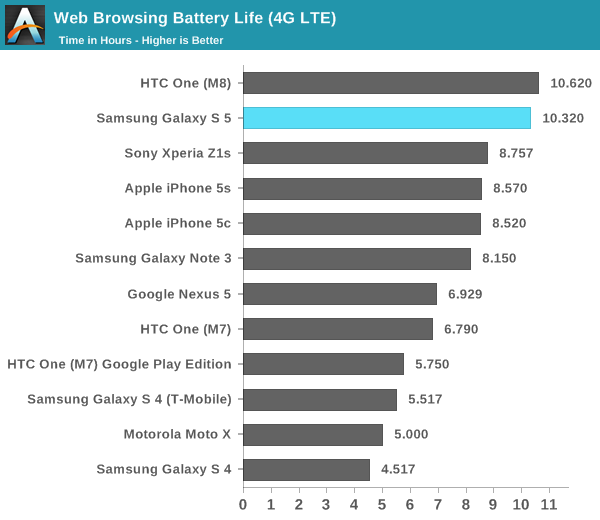
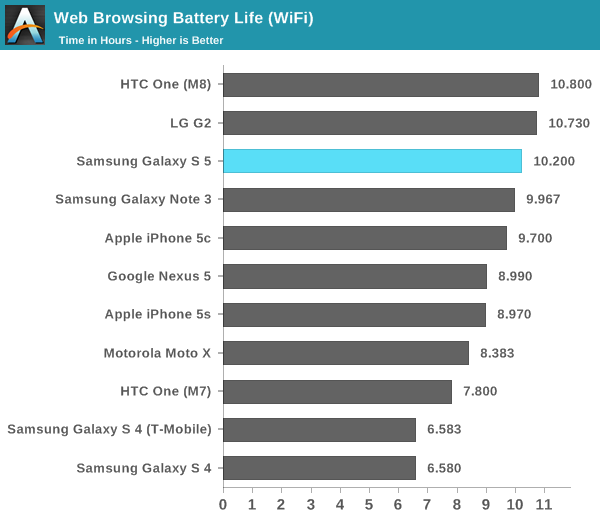
More often than not, when you’re faced with faster compute you end up doing more. To see what the other extreme of battery life looks like (where we aren't bound by display power) I turned to two canned tests: BaseMark OS II and GFXBench 3.0.
I ran both of these tests under the same controlled conditions we always use, with all displays calibrated to 200 nits. BaseMark OS II runs through a bunch of CPU and storage benchmarks (basically the same tests used for the BaseMark OS II system and memory tests), as fast as possible, until the battery dies.
I like this benchmark as it gives us an indication of worst case battery life if you’re absolutely hammering the CPU (and storage) relentlessly.
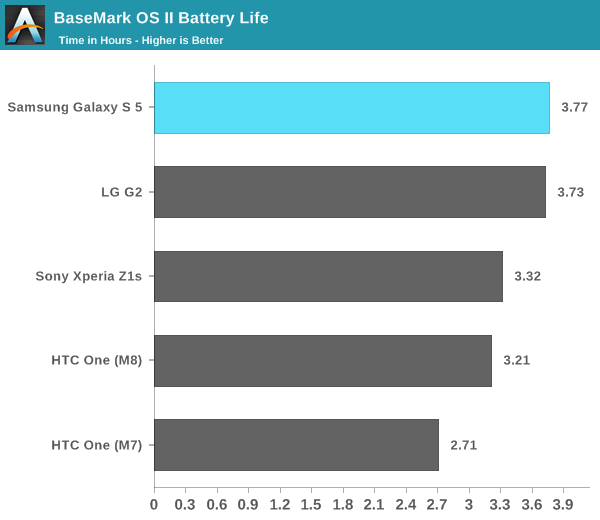
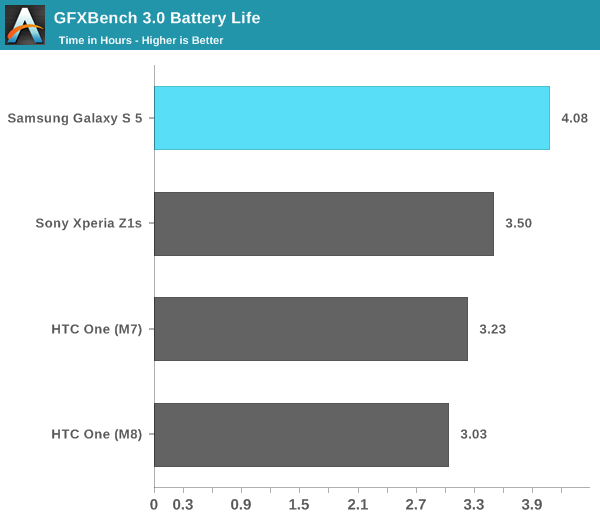
While the M8 outlasted the Galaxy S 5 in our web browsing tests, the GS5 pulls ahead in our two compute bound tests. To better understand why, let's look at what happens to the GS5's performance over time during the GFXBench 3.0 test:
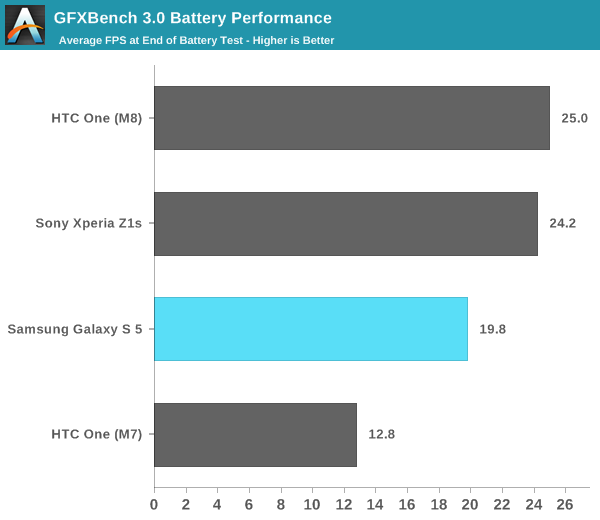
While the M8's thermal chassis is able to dissipate heat nicely and keep the SoC running closer to full clocks, the GS5's plastic body acts as more of an insulator and forces GPU clocks down over the duration of the test. The result is a reduction in performance, but an increase in battery life. The Galaxy S 5 won't let you run the battery down as fast as you could due to thermal limitations of the chassis.
Charge Time
Samsung includes a 5.3V/2A charger in the GS5's box along with a USB 3.0 cable. You can still charge the GS5 using a USB 2.0 cable as well. Despite an increase in battery capacity, the GS5 can attain a full charge in less than 2 hours. Combining excellent battery life with a very short charge time, the Galaxy S 5 is a solid performer for anyone who is on the go.
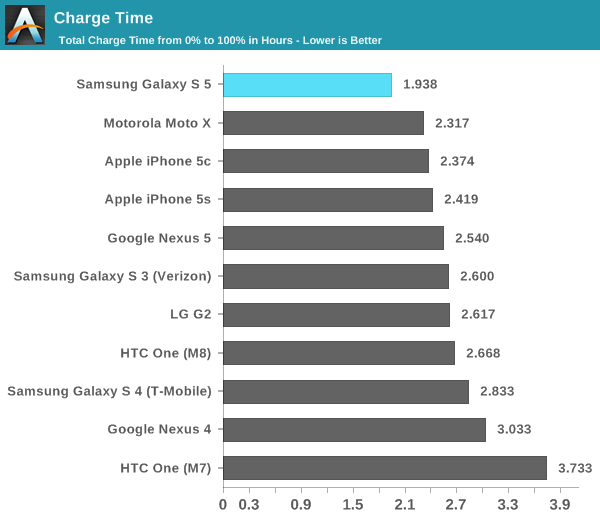











296 Comments
View All Comments
nerd1 - Wednesday, April 9, 2014 - link
Samsung still makes the most well-around and practical phone out there. It's funny so many people are crazing the metal stuff that bends and scratches without case.synaesthetic - Wednesday, April 9, 2014 - link
I used to love Samsung phones, but not so much anymore. If I'm going to spend 600 bucks on a phone, can we please stop making it feel like a toy? I'm not saying anything about using metal; Nokia's Lumia devices are made of polycarbonate but they feel rock-solid and excellently constructed.AMOLED? Meh. IPS is where it's at. AMOLED's oversaturated to the point of cartoonishness. With AMOLED, in six months of decently heavy use, tons of the blue subpixels burn out and the display gets weird unless you're very, very careful to make sure that all your subpixels wear evenly. White webpages drain the crap out of battery. I had a Galaxy Nexus for eighteen months (the one with the RGBG pentile matrix that's supposed to reduce the effects of subpixel burn out) and within half that time I had blue stripes where the status bar and nav bar were whenever I put it in landscape mode. IPS doesn't have this issue; my Nexus 4's screen looks exactly the way it did when it was new, eight months later.
The only new device I really care much about right now is the Xperia Z2. Sony phones have been awesome for a while now except for Sony's insistence on using crap screens, but the Z2's display is amazing. Not oversaturated, looks natural and fantastic, has great viewing angles... not to mention an sdcard slot and a gigantic battery.
Samsung doesn't sell a ton of phones because they're the best device, just like Apple doesn't. They both sell a ton of phones because they both spend a ridiculous amount of money on marketing.
ashleynelson548 - Wednesday, April 9, 2014 - link
My review is simple. Get in line and get this phone: http://amzn.to/1ksys3o - Got a chance to test it and this is one awesome phone. Finally Samsung got something right with the S5. I've had HTC & Samsung phones prior to the Galaxy series came out. And nothing has come close to this phone. Great resolution, great camera, love it still has a sd slot to expand your storage capacity along with the high gb internal memory. Lots of ways to tweak to your liking.SymphonyX7 - Thursday, April 10, 2014 - link
Anyone know how Anandtech measure the phone's power consumption? Do they just hook up a voltmeter between the battery terminals, get the voltage readout and compute from that?nerd1 - Thursday, April 10, 2014 - link
I think they used in-line powermeter.Stiv21 - Thursday, April 10, 2014 - link
This fake , here's flagshiphttp://pdadb.net/index.php?m=specs&id=6040&...
RonaldNCoady - Friday, April 11, 2014 - link
People who are been obsessed with stock experience pushed to their phones the minute Google announces a new update buy a Nexus phone. Everyone else buys the phone they feel best suits them. Most people teds to buy Galaxy S phones, simply because they are the best, and one of the very few with an OLED display. http://evo9.it/qr.net/aacrodex - Friday, April 11, 2014 - link
I really didn't get the capture latency part. Unlike iphone, android phones support continuous drive, so if you want to capture multiple photos, just don't release your finger.abufrejoval - Friday, April 11, 2014 - link
I am (actually more than a little) disappointed that Samsung is trying to do the right thing on one hand with the introduction of Knox for securely running enterprise applications on these devices, yet on the other hand not taking suffient care to really enable them to be what they are:Very small and portable yet incredibly powerful workstations, quite capable of replacing entry level PCs by just sticking them into (better placing them on a wireless) docking station, which has a set of full sized screens, keyboard and mouse connected to them so you can run either light office applications right off the phone or use Citrix (or any other terminal server protocol) for some heavier stuff, which still requires a beefy VDI to run.
To call them "phones" today is like calling a PC a "word processor": Sure that's how they started, but that's not what the have become.
I bought the Note 3 (like its predecessor, a Note 1) as a very personal workstation, also bought the docking station, which gave me HDMI video and audio out as well as 3 USB (2.0) ports, but I was extremely disappointed to find that the "handheld workstation" wouldn't properly initialize the Asix USB Ethernet adapter, which *every* Android I've ever tried works with out of the box.
And the monitor was little better: Even though the phone's screen is actually turned off with KitKat and orientation properly switches to landscape mode, all UI elements look groteskly swollen because they were sized to fit a 1080p resolution on a ~6" screen, but not the 32" LED TV I use on my desktop. Needless to say that word processing is no fun when letters are taller than your thumb.
Clearly the only use case Samsung seems to support via the HDMI port is watching movies: Something I don't need a workstation for.
After no essential Knox features or applications were forthcoming I went ahead and rooted my Note 3, essentially killing any chance of ever using Knox on that device now. With two "netcfg eth0 dhcp" commands in sequence I can now properly bring up Ethernet and thus connect to the securized office LAN and run Citrix, but with the built-in and fixed DPI settings all other desktop use is still painful to look at.
There are of course solutions to that problem: Any Parandroid ROM and derivative has wonderful multi-DPI support built in, but unfortunately since the MHL adapter in the Samsung devices doesn't have an open source driver, you immediately loose the HDMI connect, once you put one of these multi-DPI capable Androids on the workstation: Catch-22!
The only one who can fix this is Samsung and it doesn't look like they are using this opportunity to make their devices more appealing for enterprise use.
I have quite a number of Android devices and having a different flavour on each one of them would make them pretty unusable. So I put Omnirom on all my Galaxys (except the Note 3), my Nexus 4, 7, 10, Oppo Find 5, Asus TF101, Notion Ink Adam and even switched the return and menu keys around on all the Nexus devices to put them back where "God" (Samsung) intended them to be on my first Galaxy S, with home in the center.
And since the original launchers were always far too limited and boring I've been running SPB 3D shell on all of these devices for years, which gives me both speed and a nice look as well as a level of consistency across phone, portrait and landscape tablet sized Androids, not possible otherwise.
Custom Androids give me choice, configurability and privacy: Let the hardware vendors concentrate on creating the best workstation they can make and leave the OS alone!
I bought a post-PC darn it, like in "personal" not a blackmail subscription!
tomgadd - Sunday, April 13, 2014 - link
Why are the tester do not test audio quality??The background is, that people between 15-30 years do consume 90% of music on their smartphone. So it would be a smart move to give the audio quality a higher priority in the test.
Finally the S5 has in my view the best audio quality available on a smartphone these days.
A really smart move from samsung....that was formerly one of the key the departements of apple....Sadly the competitors needed a few years to understand the importance...